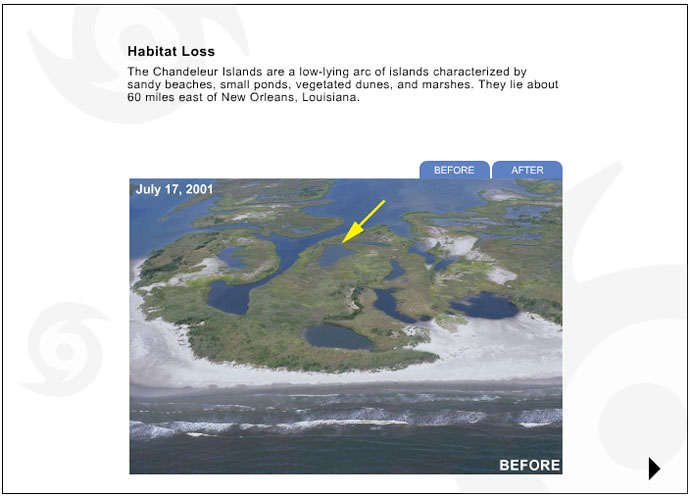Hurricane Katrina - Environmental Consequences
Hurricane Katrina caused enormous and obvious harm to human health and property. The storm also severely impacted the natural environment of the Gulf Coast. Many government agencies and academic institutions are surveying the region's habitats and organisms and making plans for long-term monitoring. The lasting consequences of Katrina on the biological and geological processes of the region will not be known for some time. But some effects of the storm are already clear.
In this activity, you will examine before and after photographs taken in areas affected by Katrina for indications of the hurricane's environmental impact.
Instructions: The following images are in pairs. Each set of photographs shows the same location, but one picture was taken before Hurricane Katrina, the other was taken shortly after the storm. Examine the images carefully for changes in topography, vegetation, and development. Then answer the questions about these differences.
Questions
- What habitats are found on the barrier islands along the Gulf Coast? How were they affected by Hurricane Katrina?
[Check Answer]
These islands have sandy beaches, salt and fresh to brackish water ponds, marshes, and vegetated dunes. In some cases these habitats were destroyed when large parts of the islands were washed away. Others were heavily damaged, perhaps permanently, when they were covered by sand or inundated by salt water. These losses are worrisome because such habitats were already greatly reduced by development. Displaced inhabitants may have a difficult time finding similar environments elsewhere.
- How did Katrina alter the topography of coastal areas?
[Check Answer]
The powerful waves kicked up by the storm and the scouring action of the storm surge rearranged many coastlines. Some beaches washed into the sea and dunes were leveled. Part of this material was swept into deep waters offshore, part of it buried streets and yards some distance inland. A number of barrier islands were essentially shifted sideways when sand was stripped from their upwind edges and dropped on their downwind sides.
- Should efforts be made to restore beaches and islands impacted by Katrina? Explain.
[Check Answer]
There is a strong economic incentive to repair these areas. Beaches are an important community asset and vital to tourism in many coastal towns. Many barrier islands are heavily developed and a number of homes and businesses could be lost if the islands aren't stabilized. However, hurricanes are part of the natural processes of the Gulf Coast. Trying to reverse their effects seems futile, since the next storm is likely to cause the same changes once again. It may make more economic and environmental sense not to repeatedly develop areas prone to erosion and rearrangement by storms, and instead to allow normal geologic and biologic processes to proceed.
- What sorts of pollution problems did Katrina create? How might these problems affect terrestrial ecosystems? How about marine habitats?
[Check Answer]
Katrina damaged or destroyed hundreds of thousands of homes, businesses, factories, and a great deal of infrastructure. These structures were broken into enormous piles of solid waste, much of it contaminated by exposure to polluted mud and water. Inevitably, toxic chemicals and heavy metals were released when everything from household bottles to industrial drums were spilled, crushed, or punctured. Sewage was released from shattered pipes and treatment plants. Oil and gas spilled from sunken ships, toppled drill rigs, and overturned vehicles. The storm surge contaminated soils, ponds, and marshes with salt water.
Soil and freshwater sources throughout the Gulf Coast region are contaminated by a complex brew of chemicals and bacteria. Some of this material will break down fairly quickly under exposure to sunlight and air, or be washed away by rain. But other chemicals will doubtless linger in the ground for some time, where they may be taken up by plants and ingested by animals. Dissolved material washed into the sea could affect the health of marine organisms, although the size of the Gulf and waves action could dilute and disperse many dangerous chemicals. Solid debris washed offshore could smother and choke bottom-dwelling plants and animals.
Critical Thinking
Speculate on possible ecological benefits caused by Katrina.Scientists seek to understand and explain how the natural world works. Many of the questions raised in this endeavor have no absolute answers.
Hurricanes are a part of the Gulf Coast environment, and ecosystems there evolved under the influence of their occasional action. The destruction of many organisms and habitats is likely to provide others with the space and opportunity to flourish. Some species may be able to take advantage of the influx of nutrient washed into the sea. For animals that are harvested for seafood, the near destruction of fishing fleets and processing facilities throughout the region may provide a respite that will allow populations to grow and assume more natural age and distribution patterns.
Related Links
Multimedia Discovery Missions: Lesson 14 - Hurricanes


